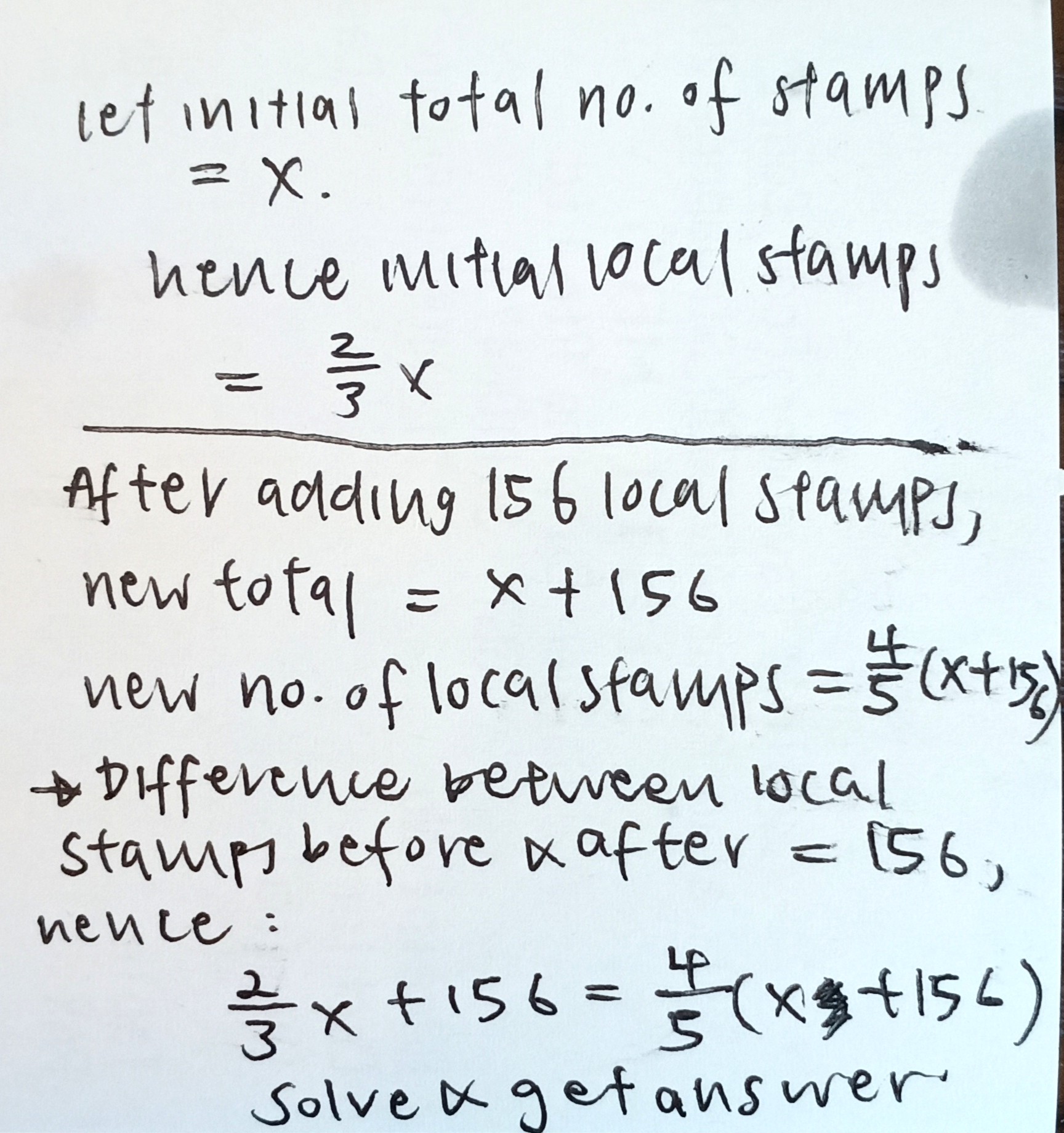Ask Singapore Homework?
Upload a photo of a Singapore homework and someone will email you the solution for free.

Question
primary 5 | Maths
| Fractions
One Answer Below
Anyone can contribute an answer, even non-tutors.

Hi . Please help. I'm struck halfway but don't know is it correct at first working or not . Thanks for helping
The total number of stamps changed so we cannot just take 4/5 - 2/3.
2/3 of local stamps at first is 2/3 of a certain number
But after adding 156 stamps, the number increased.
So now local stamps is 4/5 of the total. But it's 4/5 of a bigger number than before, not the original.
You can only do 4/5 - 2/3 if the total is unchanged.
*Also note the presentation of working.
7/15 = 156 is mathematically incorrect.
It should be :
7/15 of all stamps = 156
Or
7/15 → 156
Note that this part doesn't mean the working was correct in the first place. It's just to show you how to present correctly in future
(→ is used to mean 'refers to' or 'corresponds to')
What is unchanged? The number of non-local stamps.
Ratio method
①At first ,
Since local stamps is 2/3 of total stamps, that's 2 units out of 3. So non-local stamps are the other 1 unit.
Ratio of local : non local stamps : total
= 2 : 1 : 3
②After adding 156 local stamps,
the number of local stamps is 4/5 of total.
that's 4 units out of 5 . So non-local stamps are the other 1 unit.
Ratio of local : non local stamps : total
= 4 : 1 : 5
③Since the number of non-local stamps did not change, its units should be the same for both ratios.
As both units are 1 already, we don't need to change anything and can just read off directly.
So we can say :
There were 2 units of local stamps at first, and after adding 156 , there were 4 units.
The local stamps increased by 2 units.
So 2 units = 156 stamps
1 unit
= 156 stamps ÷ 2
= 78 stamps
Number of stamps in the collection at first
= 3 units
= 3 × 78 stamps
= 234 stamps
At first,
fraction of stamps that are non-local
= 1 - 2/3
= 1/3
After adding 156 stamps,
Fraction of stamps that are non-local
= 1 - 4/5
= 1/5
Non-local stamps are unchanged so the units has to be the same for both cases.
Usually we make the numerator the same to do this.
But it is already the same. Both are 1. so no need to do anything to it.
The denominator tells you number of units of stamps in total.
So at first it is 3 units. After 156 local stamps are added, it increased to 5 units
5 units - 3 units = 2 units
So 2 units = 156 stamps
1 unit = 156 stamps ÷ 2 = 78 stamps
At first, number of stamps = 3 × 78 = 234
⬜→1 unit of non-local stamps
⬛→1 unit of local stamps
(Their unit sizes are the same, meaning ⬜ = ⬛)
At first ,
⬜⬛⬛
Fraction of stamps that are local = 2/3
After adding 156 local stamps,
⬜⬛⬛⬛⬛
Fraction of stamps that are local = 4/5
The increase was ⬛⬛
So ⬛⬛ = 156 stamps
⬛ = 156 ÷ 2 = 78
And recall from above that ⬜ = ⬛ so ⬜ also = 78
At first,
⬜⬛⬛
= 3 × 78
= 234
See 1 Answer






Simple linear equations involving one variable are only covered in Secondary 1 (Chapter 5)